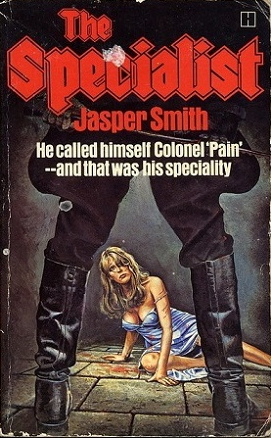 By JASPER SMITH (Hamlyn; 1979)
By JASPER SMITH (Hamlyn; 1979)
Here we have the fictional equivalent of those Nazi-sploitation movies prevalent in the 1970s, a WWII set thriller that centers on attractive women undergoing sexual torture at the hands of sadistic Nazis. Admittedly, author Jasper Smith does appear to have had a bit more on his mind than trashy exploitation, providing a great deal of thoroughly researched historical detail and some potent character shading. THE COLLECTOR it definitely isn’t, but THE SPECIALIST is a bit more substantial than ILSA, SHE-WOLF OF THE SS.
The place is Germany in the summer of 1944. The July Bomb Plot, in which some renegade German soldiers tried, and failed, to assassinate Adolph Hitler, has just occurred, and set in motion “the bloodiest campaign of revenge known in modern history.” Enter the title character, a high ranking, torture-happy Nazi colonel who calls himself, appropriately, Colonel Pain. He has two women, one a luscious Prussian countess and the other a young gipsy named Rupa, kidnaped and brought to his luxurious mansion. Here the ladies are subjected to all manner of torture, initially in an attempt at ferreting out information. As the days stretch on, though, it becomes clear that the colonel and his equally depraved subordinates are simply enjoying the torment.
The unpleasantness to which the gals are subjected includes mass rape and electric shocks applied to their nether regions. The Countess and Rupa eventually meet, and form an alliance against Colonel Pain, hatching as escape plan that’s given credibility by the fact that the allies are winning WWII. This is a fact known also to the supporting cast, which includes Heinrich Himmler, the main architect of the holocaust, and a sadistic woman identified as “The Widow,” who dishes out a great deal of torture but ultimately proves herself an unexpected ally to the Countess and Rupa. It all concludes in a rushed and unsatisfying finish in which many a just dessert is handed down, but not very convincingly.
An opening page acknowledgement by the author credits an associate with “transcribing my abominable manuscript into something approaching recognizable English.” Perhaps not all of that “abominable manuscript” was thus translated, as the prose is often dense and difficult to follow, with a tendency to leave out certain telling details—although definitely not in the passages describing rape and/or torture, which in keeping with the book’s overall gist are as graphic and leeringly detailed as possible.
